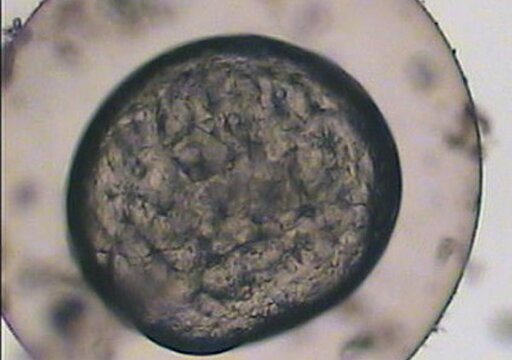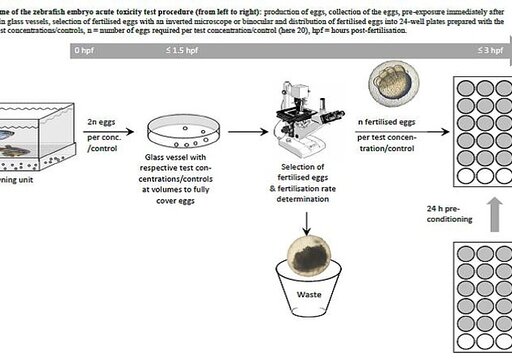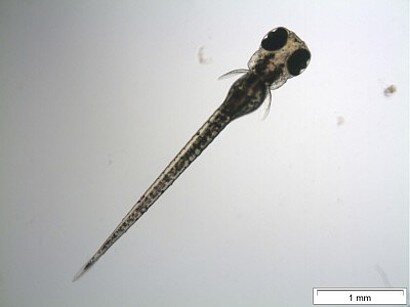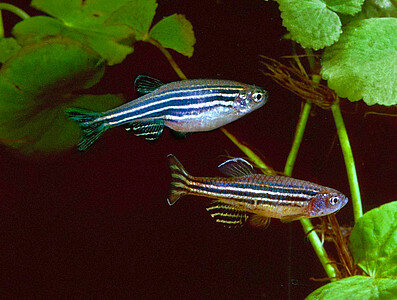
Fish Egg Test
DIN EN ISO 15088
Principle
The fish egg test with the zebrafish (Daniorerio) is designed to determine acute toxicity of water constituents and effluents on embryonic stages of fish. It was established as an alternative approach to classical acute fish toxicity testing and is considered to be a “sub-organismic” test, since the central nervous system is not yet developed during the test period.
Abstract
Newly fertilised zebrafish eggs are exposed to effluents for a period of 48 h. Death of embryos and certain defined disturbances of embryonic development, which finally lead to death, are considered effects. At 24 and 48 h, four apical observations are recorded as indicators of lethality:
-
coagulation of fertilised eggs,
-
lack of heartbeat,
-
lack of detachment of the tail-bud from the yolk sac,
-
lack of somite formation (criterion of wíthdrawn DIN 38 415-6, is only recorded).
At the end of the exposure period, acute toxicity is determined based on a positive outcome in any of the four apical observations recorded and the lowest ineffective dilution (LID) (dilution at which 90% of the fertilised eggs survive) is given as test result.

Fish Embryo Acute Toxicity (FET) Test
OECD 236, Regulation (EC) No 440/2008 C.49
Principle
The Fish Embryo Acute Toxicity (FET) test with the zebrafish Danio rerio is designed to determine acute toxicity of chemicals on embryonic stages of fish.
Abstract
The FET test takes a position between the acute fish test and the fish egg test. While the acute fish test only detects effects on adult fish and the fish egg test only on early egg development, the FET test evaluates the entire egg and embryonic development up to hatching.
For the FET tests newly fertilised zebrafish eggs are exposed to the test chemical for a period of 96 hrs. Every 24 hrs, up to four apical observations are recorded as indicators of lethality: (i) coagulation of fertilised eggs, (ii) lack of somite formation, (iii) lack of detachment of the tail-bud from the yolk sac, and (iv) lack of heartbeat. At the end of the exposure period, acute toxicity is determined based on a positive outcome in any of the four apical observations recorded, and the LC50 is calculated.

Fish Early Life Stage (FELS) Toxicity Test
OECD 210, Regulation (EG) Nr. 440/2008 C.47
Principle
The Fish Early-life Stage Toxicity Test (FELS-Test) detects lethal and sub-lethal effects of chemicals on early life stages of fish, especially of zebrafish (Danio rerio).
Abstract
The test is initiated by placing fertilised eggs in test chambers containing the dissolved test item and is continued until the control fish reach a juvenile life-stage. The FELS-Test thus allows assessment of chronic effects with respect to an important part of the life cycle of Danio rerio. The test duration is 30 days post-hatching that means 34-35 days. Lethal and sub-lethal effects are assessed and compared with control values to determine the lowest observed effect concentration (LOEC) in order to determine the (i) no observed effect concentration (NOEC) and (ii) ECx (e.g. EC50) by using a regression model to estimate the concentration that would cause a x % change in the effect measured.
Endpoints
The focus of evaluation endpoints is on survival, time of hatching, abnormal appearance and body length resp. weight. Other observations such as abnormal behaviour are also reported.

Fish Test (acute toxicity)
OECD 203, Regulation (EC) No 440/2008, C.1, DIN EN ISO 7346-1, DIN EN ISO 7346 Ospar PARCOM Proceeding with marine species
A) Single substance testing
Principle
Determination of acute toxicity on fish (96h) of a test substance.
Abstract
The fish are exposed to the test substance by means of a serial dilution for a period of 96 h. In parallel, a control test line is run without test substance. After 24, 48, 72, and 96 h, the mortalities and the test conditions (temperature, pH, and oxygen content) are recorded. The LC50 (lethal concentration for 50% of the test fish) is calculated as test result from the dose-effect relationship. From the test data, also the LC0 (highest concentration at which all fish survive) and the LC100 (lowest concentration at which all fish die) is estimated.
Test systems
According to OECD 203 or EU 92/69/EEC, C.1, various test fish species can be used: Danio rerio (zebrafish), Pimephales promalas (fathead minnow), Cyprinus arpio (common carp), Poecilia reticulata (guppy), Lepomis macrochirus (bluegill), Oncorhynchus mykiss or Salmo gairdneri (rainbow trout).
For chemicals that can enter the marine environment (e. g. chemicals used in offshore petroleum industry), the OSPAR Commission for the protection of the marine environment of the North-East Atlantic as well as the European Union considers a risk assessment approach based on marine tests. According to the "OSPAR PARCOM Protocols on Methods for the Testing of Chemicals used in the Offshore Oil Industry", the turbot (Scophthalmus maximus) or the sheepshead minnow (Cyprinodon variegatus) are used as marine test fish.
Test substance properties
Dependent on the characteristic of the test substance the design of the test will be adapted: static test design without renewal of the test solution for soluble substances and semistatic test design with renewal of the test solution after 24, 48 and 72 hours for unstable substances.
Foranimal protection reasons, the number of test fish has to be restricted to a minimum. Therefore, according to the OECD Guidance No. 126, the implementation of a "limit test" with the lowest EC50 concentration achieved in the algae or daphnia test is considered before performing main test to determine exact LC50.
B) Waste water evaluation
As part of the amendment of the Wastewater Ordinance from June 17, 2004, the fish toxicity test (DIN 38412-31) has been replaced by the fish egg test for wastewaters. Only in exceptional and well motivated cases, e. g. to address specific questions and problems, the fish test with golden orfs (Leuciscus idus) can still be used.

